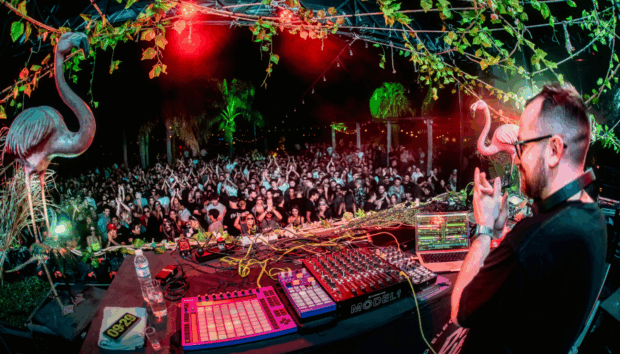
London noise-rock band Wolf Alice released their 2017 LP ‘Visions of a Life’ to critical acclaim. It was an extended LP of finely-detailed, and meticulously produced avant-pop, folk, and rock. Talking about the production experience to Native Instruments, drummer and songwriter Joel Amey describes how he first discovered KONTAKT, and how it went on to shape the sound of their latest record.
The first time I used Kontakt was when I was working with Mike Crossey on our first record, My Love is Cool. I had a keyboard part in ‘Freazy’ that we shaped using the strings bank, as well as Battery for programmed sections on tracks ‘Soapy Water’, and ‘The Wonderwhy’.
My appetite whetted. I got my hands on the software and used it for 90% of the demos I would come to write over the next two years on the road. Skip forward to 2017 and we were in Los Angeles working with Justin Meldal-Johnsen on our second record, Visions of a Life. Justin is the kind of producer who encourages everyone to be as involved and creative as possible, so that, with an added B Rig studio out the back our main studio, it allowed all of us to jump feet first down the rabbit hole with any weird ideas we wanted to explore.
The title track on Visions of a Life was one of the more ambitious studio experiences. We tracked the core instruments live in Studio 2 at Hollywood’s EastWest, before we took the project to Music Friends on Eagle Rock Boulevard (owned by Grammy award-winning legend Carlos De La Garza) to add overdubs. We had to find a balance of keeping it raw and unhinged but also focusing on each section individually over the course of its 8 minutes.
Where Kontakt was in most valuable for this song, is in the ‘third movement’ (as it was dubbed), at around 5.41 where the vocals soar up and the guitars and drums come crashing back in again. I’ve always really loved using weird brass sounds and trying to get them to mimic or bulk up with guitars – we also used Kontakt brass for the ‘stabs’ in our song ‘Giant Peach’. So I took the project into Studio B and fired up SE Brass Ensemble. Originally I just had the brass following the chord just to add some punch, but they sat a little too ‘straight’ and took it away from its original rawer, garage intention. Joff’s [Oddie] guitar track had bends and movement and I wanted to try to compliment that. I added saturation and tape delay, while mucking around with the attack and sustains until it gave me the effect I was after. If you listen closely at 6.27, you can hear the fizzy brass come in on the one-beat, almost close back in on itself before the envelope opens up again and it seems to reappear. The patch became known as ‘Fuked Brass’ and just adds a sort of nasty, doomy texture to the outro.
I’m very much a novice when it comes to using Kontakt, but thanks to the way each patch it designed, I don’t feel like one. Everything is visual, easy to control, malleable to your wants and tastes and encourages you to experiment. As our band and my writing continues, I’m excited to see how many directions we can push it with the help of Kontakt.
photo credits: Laura Allard Fleischl















